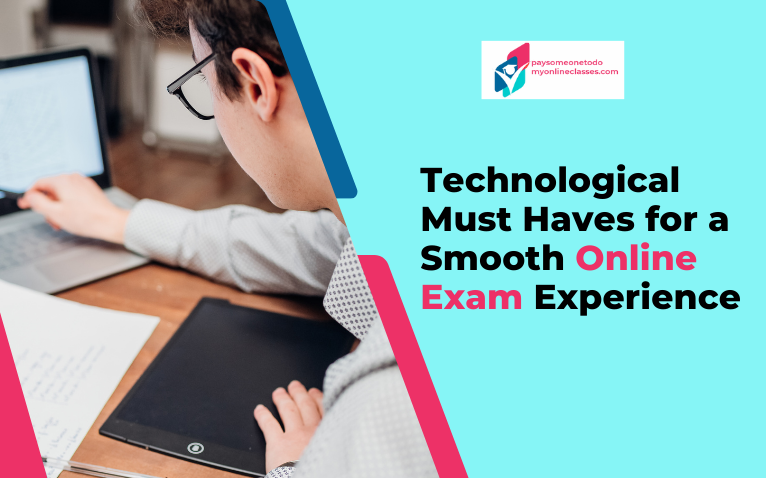Reliable High-Speed Internet
A fast, steady internet connection serves as the lifeline for online exams. Losing connectivity during a test could result in automatic submission or logging out, causing potential loss of answers. Follow these tips for keeping online:
- Use wired ethernet instead of WiFi whenever feasible, as it is more reliable. Position your device near the wireless router.
- Confirm that the internet speed meets exam requirements, typically at least 3 Mbps download and 2 Mbps upload speed. Test on speedtest.net.
- Disable bandwidth-consuming functions on other connected home devices like streaming, large uploads/downloads, video calls, etc. Configure QoS settings if your router supports it.
- Have a mobile hotspot on standby from your smartphone as a backup. Ensure sufficient cellular data balance and keep the device fully charged.
Web Camera
Built-in or external webcams allow proctoring services to monitor online exam activity for potential violations. Lacking one may make you ineligible to test. Consider these webcam best practices:
- Position it for a clear, well-lit view of your face, hands on the keyboard, workstation surface area and surroundings. Avoid having visible personal items or messages that could be deemed inappropriate.
- Check that the microphone is capturing ambient sounds. Speak out loud and replay to verify clarity.
- Grant camera access permissions to examine the browser/app exclusively by closing other applications like virtual backgrounds, camera beauty filters, etc.
- Have a government ID card ready to display on camera for identity verification requirements.
Computer Hardware
While essential online exam functions may work on a smartphone or tablet, a fully equipped Windows/macOS laptop or desktop computer enables the most seamless experience for lengthy tests involving extensive navigation, typing, reviewing, etc.
- Update your operating system, internet browser, graphics drivers, media plugins and antivirus software. Also, run a full system scan to confirm absent malware.
- Adjust display settings to the recommended resolution without scaling. Increase text size for better readability without straining or scrolling excessively.
- Have a sufficient battery charge to last the full exam duration or keep a charger handy for the plugin. For desktops, use a UPS backup power supply.
- Use a wired mouse and keyboard for speed and to prevent losing connectivity intermittently. Ensure no keys are sticky.
- Close all non-essential applications to optimize processor and memory for exam software usage needs. Disable app notifications and enable Airplane mode.
Contingency Planning
Despite adequate precautions, technology can unexpectedly fail at the worst times. Make backup arrangements to minimize disruptions to the online exam experience:
- Have a secondary internet source handy, like a mobile hotspot or a neighbor’s WiFi password.
- Keep a second working webcam available if the primary one fails. Most laptops also have built-in cameras.
- Fully charge an additional digital device like a smartphone, tablet, or spare laptop to switch to in case your computer encounters hardware/software issues.
- Maintain access to printer paper and pens in case you need to submit handwritten work.
- Note down exam provider and proctoring service technical support contact information to promptly report issues. Ask about policies for the timeframe permitted to reconnect or continue testing later.
- Ultimately, check if the exam allows dropping the lowest scores to offset potential technology-induced setbacks.
Physical Study Setup
Apart from digital devices, optimize physical desk setup:
- Find a quiet, distraction-free room with a shut door and minimum background noise. Post ‘Do Not Disturb’ signs outside to maintain isolation.
- Ensure a stable, clutter-free desk surface. Avoid handling messy foods or liquids nearby that could spill over devices.
- Arrange adequate lighting focused on your face from the source opposite the camera so visibility isn’t compromised.
- Place required items like calculators, headsets, eyeglasses, water bottles, and tissues within arm’s reach to avoid moving out of frame frequently.
Practice Mock Exams
After setting up suitable technology and optimizing the physical study setup outlined in the previous sections, the next step is to undergo some practice runs.
Attempting mock online tests before the actual high-stakes exam provides immense benefits in these aspects:
Familiarize yourself with Platform Interface to secure online exam help.
- Each exam software platform and proctoring tool has unique interfaces, settings menus, guidelines, and help features. Mock tests allow you to:
- Get acquainted with the layout to spot exam controls like timer, question navigator, calculator, etc.
- Understand the auto-save frequency and recovery in case of disconnections.
- Learn to type responses in assigned text boxes, draw diagrams in drawing tools, toggle between questions, etc.
- Find out how to flag, bookmark, highlight, or strikethrough questions and return later.
- Practice downloading question papers or uploading answer sheets post-submission.
- Enable you to reach out to mock test support staff to clarify doubts.
Staying on top of these technology, environmental, and preparedness measures will enable you to focus solely on the actual exam content rather than operational issues. Be proactive in your approach for smooth sailing with !
Conclusion
Online exams have brought a prominent assessment method in the ever-evolving education landscape. These exams offer flexibility and convenience. But, it requires careful preparation and the right technological tools. However, an environment conducive to improved performance is now achievable. Here’s where having a dependable internet connection is helpful. Additionally, you must possess a compatible device, backup power, noise-cancelling headphones, and exam lockdown software
Additionally, you can enhance your online exam experience as you familiarize yourself with these platforms related to courses and exams. Another way will be to maintain an open channel that can boost the online exam experience.
- Online Learning and Global Education: Expanding Cultural Perspectives - January 23, 2024
- How to Leverage Online Learning Communities for Career Advancement - January 22, 2024
- How To Overcome Exam Stress The Common Issues Affecting Students - January 17, 2024

